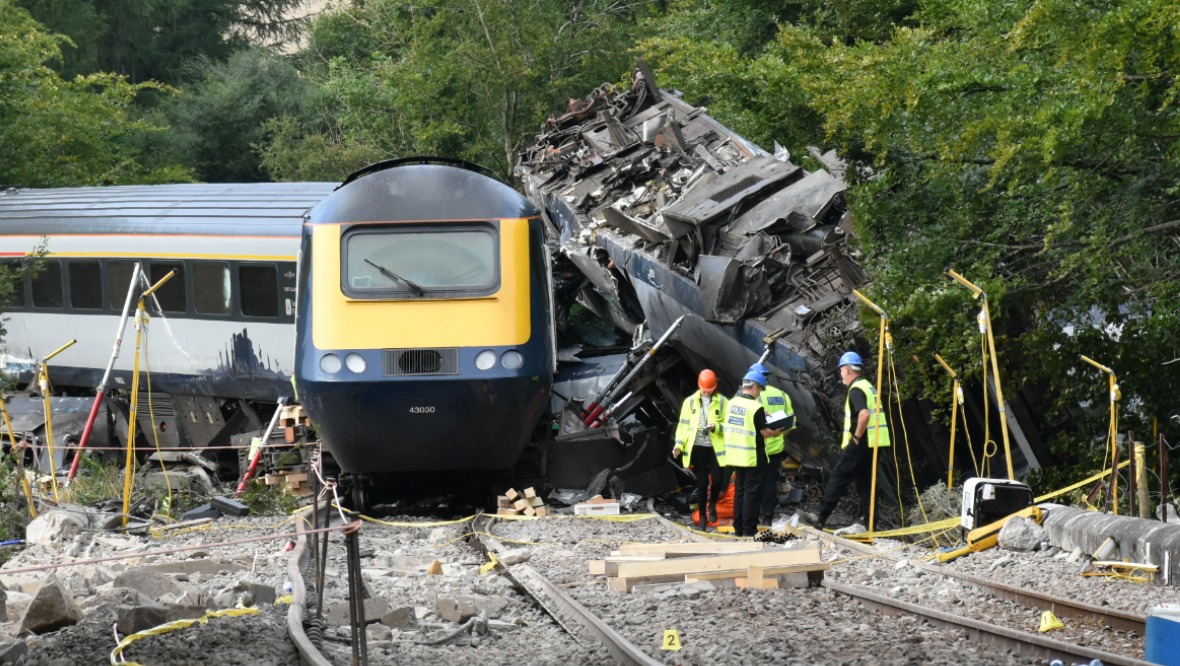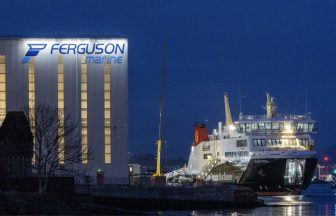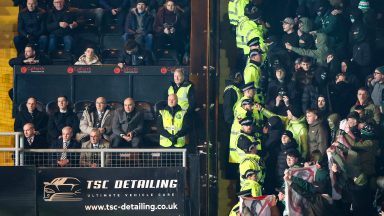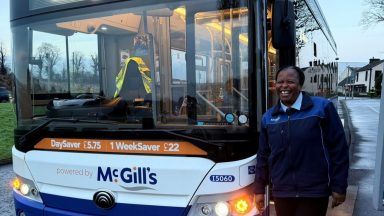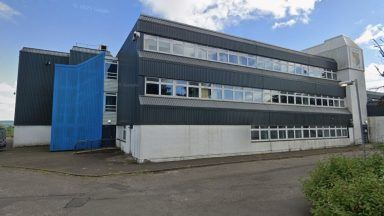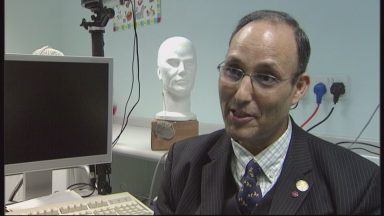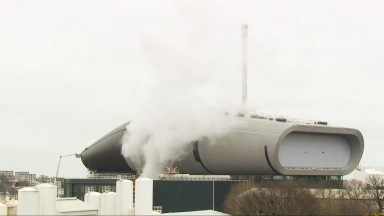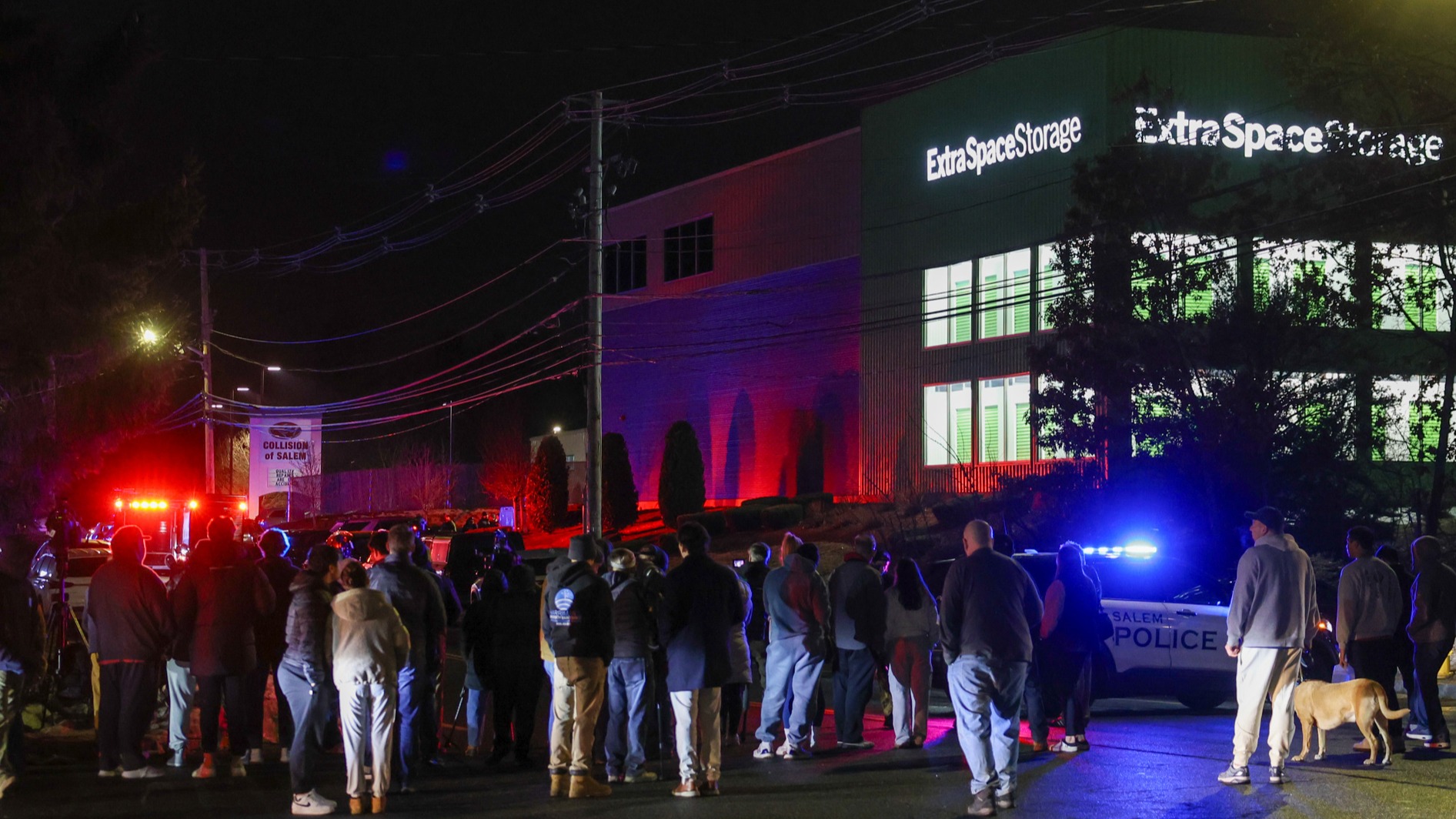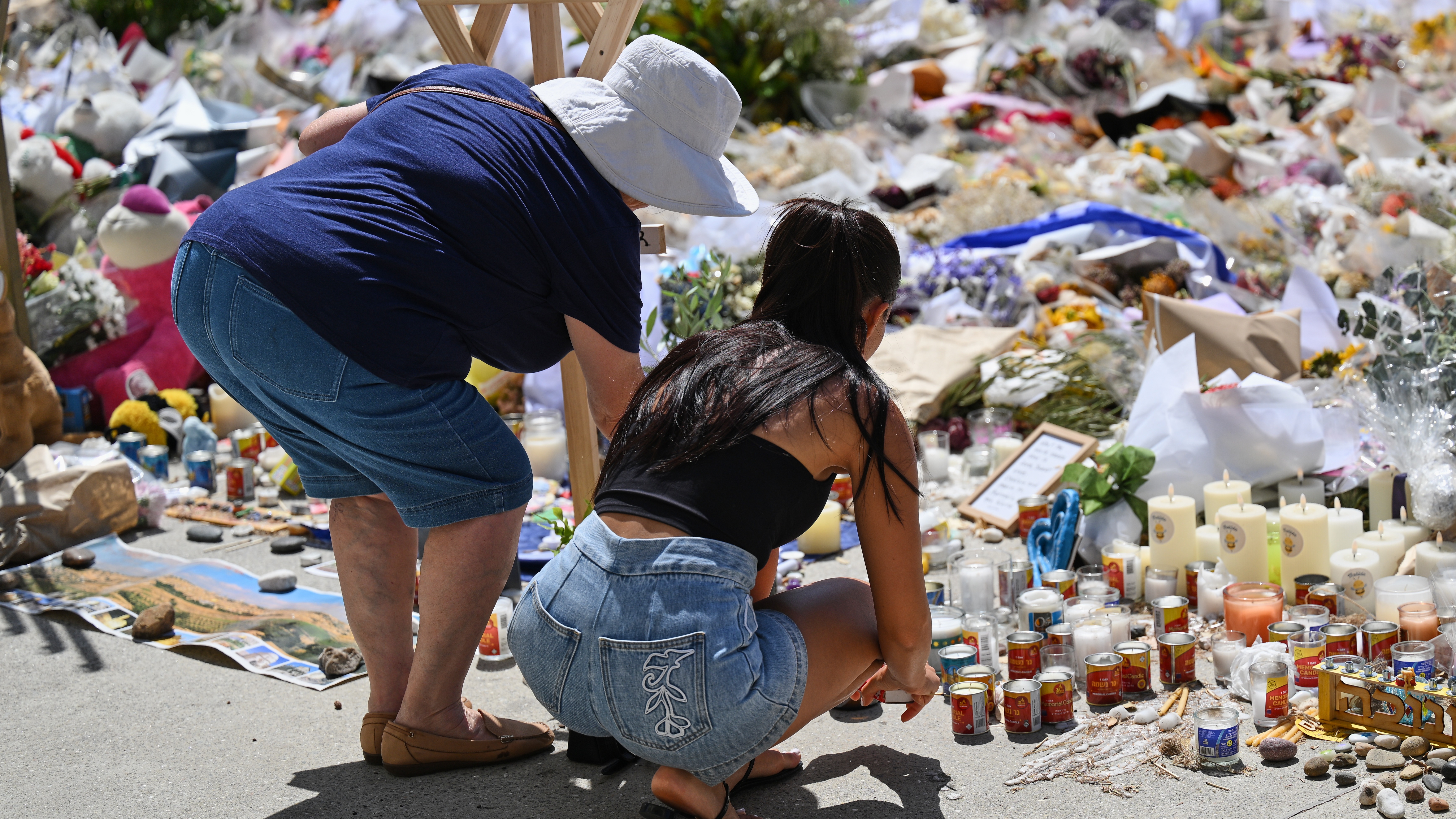The fatal Stonehaven train crash was caused by a drainage system unable to cope with heavy rain, an investigation has found.
The Rail Accident Investigation Branch (RAIB) concluded that errors made during the system’s construction by failed firm Carillion led to the derailment on August 12, 2020.
Network Rail was also criticised for failing to carry out inspections that might have identified the problem.
Three people were killed when a ScotRail train came off the tracks at 9.37am at Carmont, Aberdeenshire, after hitting gravel and other stony material washed out from the drain.
They were the driver Brett McCullough, 45, the conductor Donald Dinnie, 58, and a passenger, Christopher Stuchbury, 62.
 STV News
STV NewsThe other six people onboard were injured after the train smashed into the side of a bridge, causing its power car and one of its four carriages to slide down an embankment.
The drainage system was built during 2011 and 2012 to address a problem with ground stability.
Simon French, the chief inspector of rail accidents at RAIB, said: “The tragic irony of this accident is that the drain which failed during extreme weather at Carmont was installed to manage the risk to the earthworks due to intense rainfall.
“The drain had been designed to accommodate a one in 100 year [weather event] and that is pretty much what happened at Carmont on that day.
“But the drain had been installed incorrectly and the changes of the design hadn’t been referred back to the designers, so no one had appreciated the tragic unintended consequences.”
What went wrong with the drainage system?
The most significant difference between the design of the drainage system and its construction was the addition of a bund – a structure to protect against leaks – which significantly altered the flow of water.
On the day of the crash, this caused a large amount of water to be diverted into the drain at one location, increasing the likelihood of gravel being washed out.
The RAIB concluded that if the system had been built in accordance with designs, it was “highly likely to have safely accommodated the flow of surface water”.
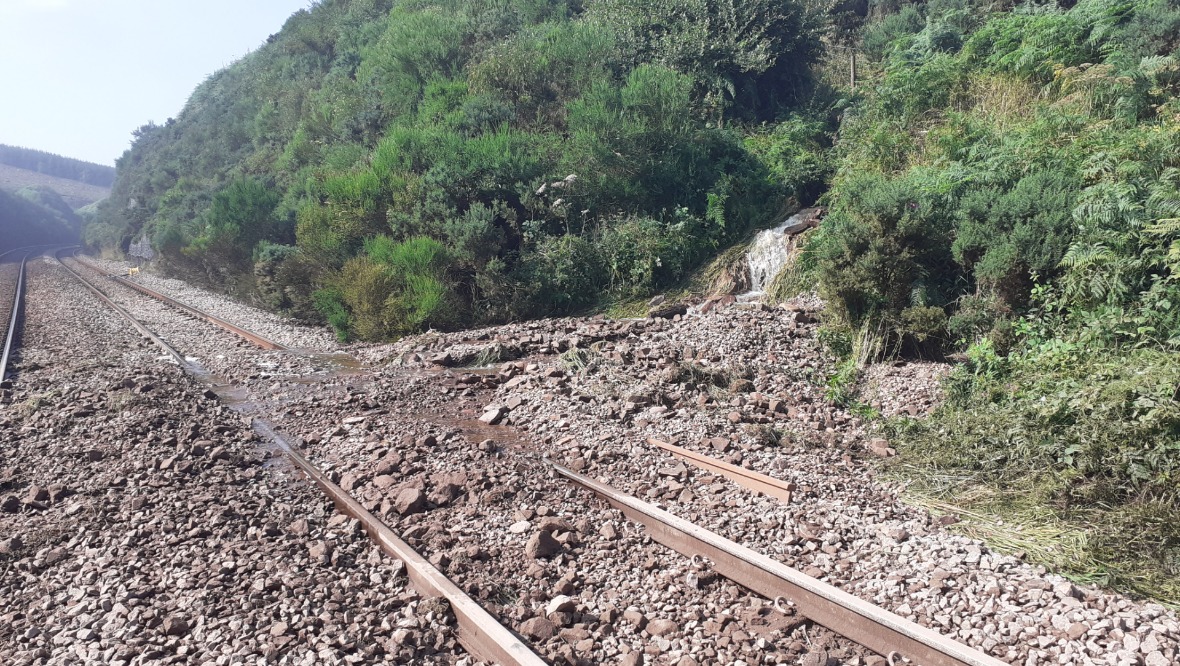 Contributed
ContributedCarillion, which went into liquidation in January 2018, failed to inform Network Rail it was adding the bund.
Investigators found no evidence that Network Rail carried out any inspection of the upper parts of the system between when it viewed the completed work in March 2013 and the accident.
They stated that the UK Government-owned company failed to add that section of the structure to an internal programme, which would have triggered routine inspections and maintenance.
The inquiry also noted that the owner of the land where the system was installed took a photograph showing “slight erosion” in December 2012, which he passed on to Carillion or Network Rail.
This was “clear evidence of a problem requiring action”, the report stated.
How have the families reacted?
A statement from the family of Donald Dinnie, the train’s conductor, said: “We are very grateful for the way the RAIB has painstakingly handled this investigation and our thanks go to them for their diligence and consideration in reaching their conclusions.
“For us, whilst losing a loved one in these dreadful circumstances has been totally devastating, we also reflect that this accident happened at a time when the early stages of the pandemic saw fewer people travelling.
“This, in our view, has made the RAIB investigation more personable, and it has been handled with extreme patience and sensitivity, and we thank them for that.”
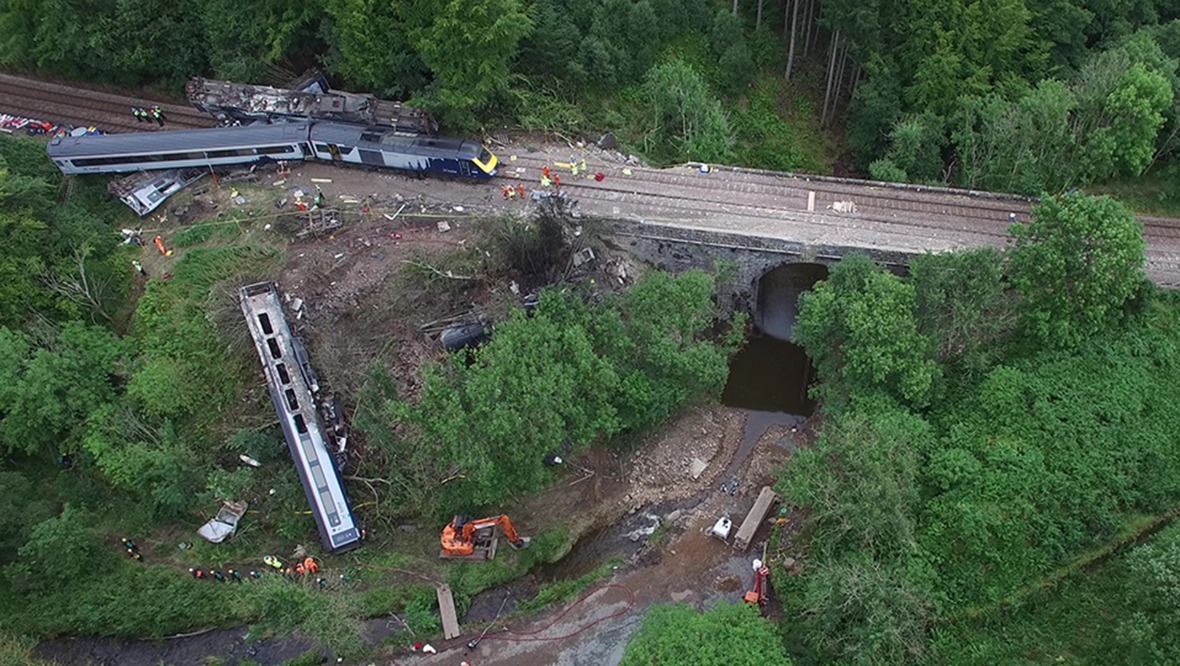 Contributed
ContributedLawyer Julie Clark-Spence, a partner at Balfour+Manson in Aberdeen who is representing the family, added: “I know from speaking with the family that one of Donald’s prime considerations was the safety of his passengers.
“He took this responsibility very seriously and it’s reassuring that the findings and recommendations of this RAIB report should help make the railways safer for generations to come.
“The family welcome the publication of the RAIB report, but we must not forget that they are grieving the loss of their loved one”.
Neil Davidson, partner at law firm Digby Brown Solicitors, which represents injured passengers and the relatives of one of the people killed, said: “This is a damning report which highlights a catalogue of failures within Network Rail.
“The RAIB investigation clearly shows rail management had prior knowledge of several known risks – they were told to improve, yet still failed to act.
“This is the very definition of negligence and as a result people were killed or injured. It should come as no surprise that many now hope further action will be taken against Network Rail.
“Right now, as a bare minimum, those responsible for running and managing the railway need to swiftly provide survivors and families with the support they deserve while implementing all of the RAIB’s recommendations in full and without delay.”
What happened on the day of the crash?
Between 6am and 9am on the morning of the accident, there was near-continuous heavy rain.
The 51.5mm which fell at the crash site was close to the average monthly total for the month of August in that region.
The 6.38am service from Aberdeen to Glasgow was returning towards Aberdeen at the time of the accident due to the railway being blocked.
It was travelling at 73mph, which was just below the normal permitted speed for that line.
The RAIB said no instruction was given by railway controllers or signallers that the train should run slower, with one signaller telling the driver the line was “fine”.
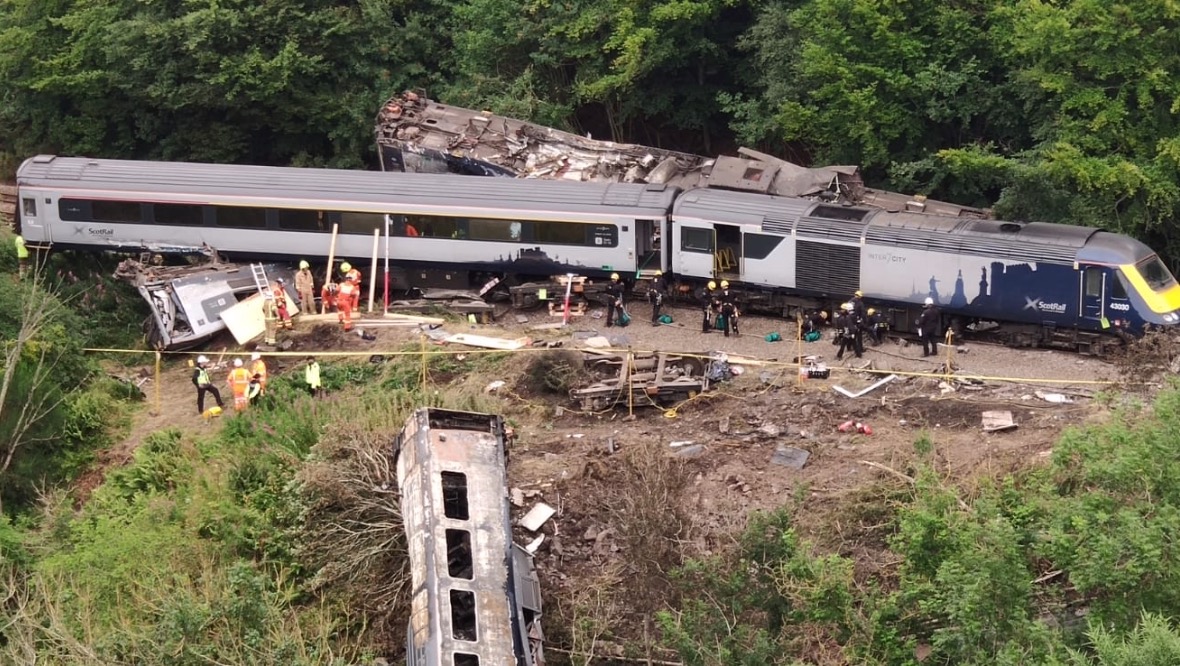 STV News
STV NewsThe inquiry found the controllers had not been given the information or training they needed to effectively manage “complex situations” such as the one they were encountering on the day of the crash.
Network Rail’s management processes had not identified or addressed weaknesses in the way it mitigated the consequences of extreme rainfall.
The organisation also failed to implement measures following previous severe weather events.
RAIB deputy chief inspector Andrew Hall said Network Rail “hadn’t moved far enough to eliminate” the risk of heavy rainfall.
The RAIB found that the refurbished HST train involved in the crash was designed before modern safety standards came into force.
It concluded “it is more likely than not that the outcome would have been better” if a train built to current regulations was involved.
Some 20 safety recommendations were made to improve railway safety, many of which were directed at Network Rail.
The crash was the first involving the fatality of a passenger onboard a train in Britain since the Grayrigg derailment of 2007.
How have Network Rail and trade unions responded?
Martin Frobisher, safety director at Network Rail, told STV News: “We are very sorry for what has happened, this report makes very difficult reading.
“The installation of the drain by Carillion back in 2012 wasn’t right. We didn’t check it properly and the operational management of the extreme weather wasn’t done properly.
“We are sorry for what has happened and we recognise it is a really difficult day for the families of those who died and were injured.
“We will definitely be adopting the recommendations from the Rail Accident Investigation Branch, in fact we’ve already done a huge amount of work since the day of the accident to improve safety, to improve the way we identify storms, control the speed of trains, we’ve inspected drains of a similar type throughout the country.”
Kevin Lindsay, Aslef’s full-time organiser in Scotland, said Network Rail “must be held to account” as they “failed the staff and the passengers who were on the train”.
Follow STV News on WhatsApp
Scan the QR code on your mobile device for all the latest news from around the country


